How to use Image Objects to Create Icons?
This article provides information on the following topics:
• Downloading and Installing Object Packs
• Defining, Creating the Icon Project
• Building the Icon Using Image Objects
• Finalizing the Icon by Creating All the Formats
Using image objects in Axialis IconWorkshopä is a child's play. Objects are present in the Axialis Librarian folder and appear in the associated integrated window (present in all Axialis products). Additional object packs can be downloaded from our website. Dealing with objects is fun and intuitive. It can be done exclusively with the mouse using drag and drops.
Before reading this tutorial, we recommend you to visit this page to learn more about Image Objects: What is an Image Object?
Downloading and Installing Object Packs
Axialis IconWorkshop™ already includes some objects packs. However, on a regular basis, new object packs will be available for download on our website. Packs are free but some of them are reserved to registered customers. Additionally, third-party authors may propose their own object packs (additional fees may be required). Links to selected object packs will also be added to our website object page![]() .
.
1. Open your Internet browser and visit our page: "Download Image Object Packs". We recommend you to read the License Agreement before downloading packs.
2. When you're interested by an object pack (click "Read More" to get additional information on this pack), click the "Download Now" button. It is an executable file (EXE) so you may be prompted by Windows® or any other antivirus application to confirm the download and execution of the file. Click "YES".
![]() Installing packages downloaded from Internet is potentially dangerous.
Installing packages downloaded from Internet is potentially dangerous.
Install packages that you download on Internet may contain viruses. However your security is our priority and all our files are periodically tested against all known viruses. Also, if you have an antivirus software installed, the file will be automatically checked before it is launched.
3. Once the file is downloaded, launch the installation and follow the procedure. When finished, the objects are installed in the "Axialis Librarian" folder. If IconWorkshop™ is installed it is automatically launched.
Defining, Creating the Icon Project
![]() To follow the tutorial below you need the "Glossy Buttons" object pack. Search the Librarian for the folder "Objects\Pack 1 - Glossy Buttons"). This pack is included in Axialis IconWorkshop 6.0 or more. If you can't find the folder, download the "Glossy Buttons" pack from Internet.
To follow the tutorial below you need the "Glossy Buttons" object pack. Search the Librarian for the folder "Objects\Pack 1 - Glossy Buttons"). This pack is included in Axialis IconWorkshop 6.0 or more. If you can't find the folder, download the "Glossy Buttons" pack from Internet.
Before using the image objects, we need to create a new icon project. An icon contains several image formats (see "What's an Icon?") so we need to define all these formats before going on.
We'll create an icon compatible with Windows Vista™ (256x256 format), Windows® XP; (48x48, 32x32, 24x24 and 16x16 formats) and Dock Bar![]() applications (128x128 format). To simplify the project, we won't add indexed color formats (256, 16 colors). Using the objects we'll make a "Glossy Earth" icon with bottom shadow. The resulting icon will look like this:
applications (128x128 format). To simplify the project, we won't add indexed color formats (256, 16 colors). Using the objects we'll make a "Glossy Earth" icon with bottom shadow. The resulting icon will look like this:
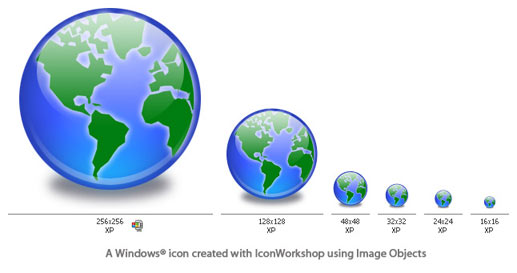
The largest image format is 256x256 Windows® XP (ie RGB with alpha channel). To get the best results, we'll start the project with this new format and work with it to assemble the objects. When finished, we'll create all the other formats using this 256x256 format as template. Let's create our new icon project:
1. Launch IconWorkshopä. Choose File/New/Windows® Icon Project or press Ctrl+W. A dialog box opens:
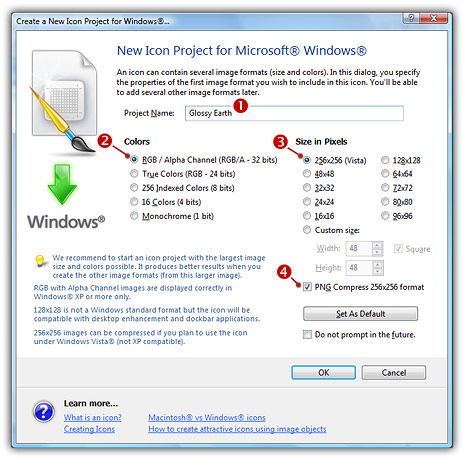
2. Type the name of the project (![]() ): "Glossy Earth".
): "Glossy Earth".
3. Now specify the format of the first image to add in the project: In Colors, choose "XP with Alpha Channel (RGB/A 32 bits)" (![]() ). In Size in Pixels, choose and "256x256 (Windows Vista™)"Glossy Earth" (
). In Size in Pixels, choose and "256x256 (Windows Vista™)"Glossy Earth" (![]() ).
).
4. As we want the 256x256 format to be used under Windows Vista™, we choose to compress it as PNG: Click the option "Compress 256x256 Windows Vista™ format" (![]() ). To learn more about Windows Vistaä icons, read this article: "Introducing Windows Vista™ Icons".
). To learn more about Windows Vistaä icons, read this article: "Introducing Windows Vista™ Icons".
5. When done, click OK. A new icon project window is created (![]() ):
):
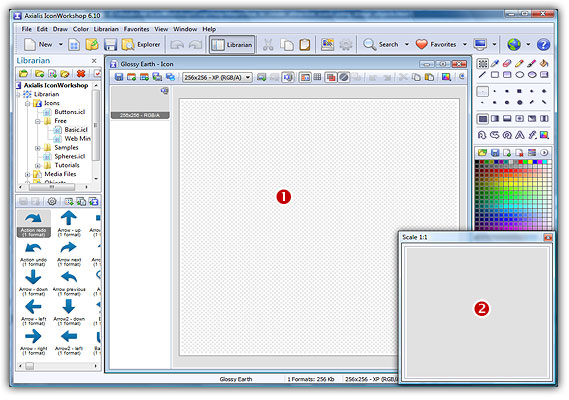
6. If the scale-1:1 preview window is not in 256x256 mode, the preview image will be cropped. It is recommended that you switch to 256x256 preview mode to work with 256x256 Windows Vista™ icons. To switch to this mode, right-click in the preview window, a menu opens. Choose "256x256 Display". The preview window now looks as shown above in floating mode (![]() ).
).
Use the same method to return to the previous state: choose "128x128 Display", remove the "Floating Window" option and use the mouse to dock the window.
Building the Icon Using Image Objects
This is the most important part of the project. The time has come to be creative! No problem it's easy and fun with IconWorkshopä. Before we start, don't forget that each step of the creation can be undone/redone (Ctrl+Z/Ctrl+Y) up to 16 steps back.
7. In the Librarian window (choose View/Librarian if it is not visible), select the "Objects/Pack 1 - Glossy Buttons/Circle" folder (![]() ). A list of available object is displayed in the contents window below (
). A list of available object is displayed in the contents window below (![]() ). Find the "Circle - Blue.png" file and select it (
). Find the "Circle - Blue.png" file and select it (![]() ).
).
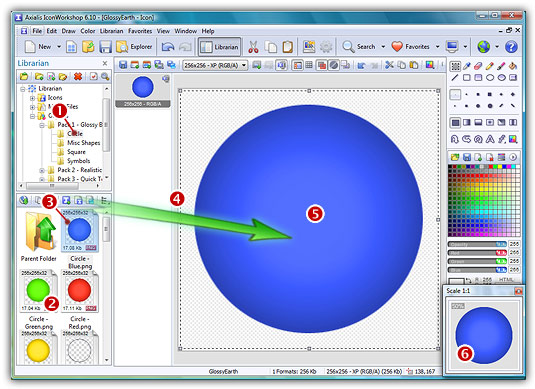
8. When done, use a mouse Drag-and-Drop to add it into the project as shown above (![]() ). The object is added to the project as a floating selection (
). The object is added to the project as a floating selection (![]() ). Take a look at the quality of the artwork in the Scale 1:1 window (
). Take a look at the quality of the artwork in the Scale 1:1 window (![]() ).
).
Congratulation! you've just added your first image object to your project! As you can see it's very easy and intuitive. Now let's continue and add other objects to build the icon.
9. From the Librarian, select the file "Circle Inner Light.png" and add it to the project using the same method. The resulting image now includes a cyan light effect as shown below:
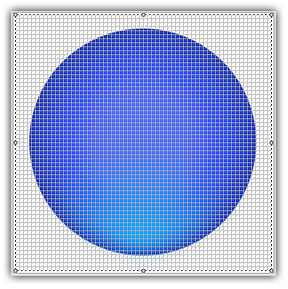
10. To create the Earth image, we now add the map object. From the librarian, select the file "World Map.png" and add it to the project using the same method. The resulting image looks like below:
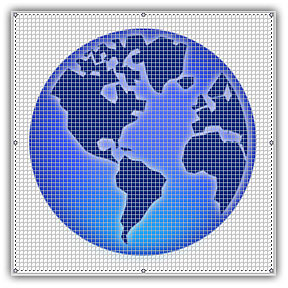
11. The result is good but we want to make it even better. We can increase the realism by changing the color of the map to green. To do so, IconWorkshopä has a feature to adjust the Hue/Saturation/Brightness of an image. Choose Draw/Adjustments-Effects/Hue-Saturation or press "U". A dialog box opens:
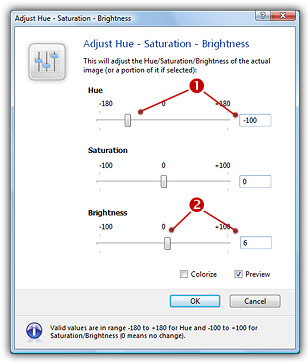
12. Set the Hue to "-100" either using the slider or by typing the value (![]() ). It "shifts" the colors of the floating image in the spectrum. As a result, the map is now green. Also, we slightly increase the Brightness of the map by specifying "6" (
). It "shifts" the colors of the floating image in the spectrum. As a result, the map is now green. Also, we slightly increase the Brightness of the map by specifying "6" (![]() ). You can see the results in real-time in the Preview 1:1 window. When done click OK. Now the map is green:
). You can see the results in real-time in the Preview 1:1 window. When done click OK. Now the map is green:
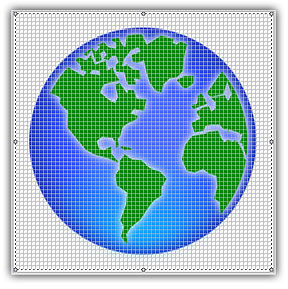
13. Do you recall the name of the icon? Yes, "Glossy Earth"! So, let's add the glossy effects. First, using the same drag-and-drop method as above, we add the object "Circle Effect 3.png". Then to increase the effect, we add the object "Circle Effect 6.png". Now it looks like this:
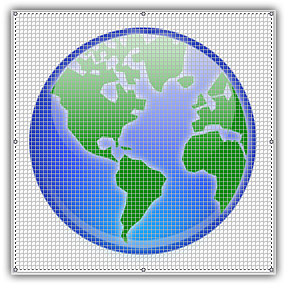
14. Now the final touch: the shadow. We want to add a shadow at the bottom and under the earth. This will produce an interesting effect, just like if the globe was laid on a white horizontal plan.
First, we need to move the whole Earth 10 pixels up (just to leave more space for shadow at the bottom of the image). Important: To do so, we must select the whole image. Actually, only the last object we've added is selected. Choose Edit/Select All or press Ctrl+A. There is no visual change but now you're ready to move the whole image.
To move the image, you can use the mouse (with a drag-and-drop) or use the arrow keys of the keyboard. To move the image 10 pixels up, hit UpArrow 10 times or press Shift+UpArrow. The resulting selection rectangle is now 10 pixels outside the top of the editor area.
15. We can now add the shadow. Select the object "Circle Shadow.png" in the librarian and add it to the project. The resulting image looks like this:
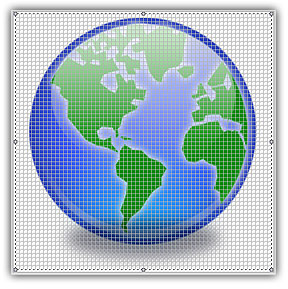
16. Obviously, there is a problem: The shadow is in front of the Earth Globe! The solution is as easy as a keystroke: Press the End key or choose Edit/Set Floating Selection to Background.
You're done! The resulting image should look like this:
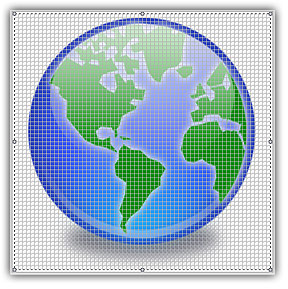
Finalizing the Icon by Creating All the Formats
Now that the largest image is done (256x256 RGB/A), we'll create all the other formats of the icons from this one. This is done in one step with Axialis IconWorkshop™ Professional Edition. Using the Personal Edition, you need to create each format manually (see product help for more info).
17. Choose Draw/Add Several Image Formats from This Image or press "V". A dialog box opens:
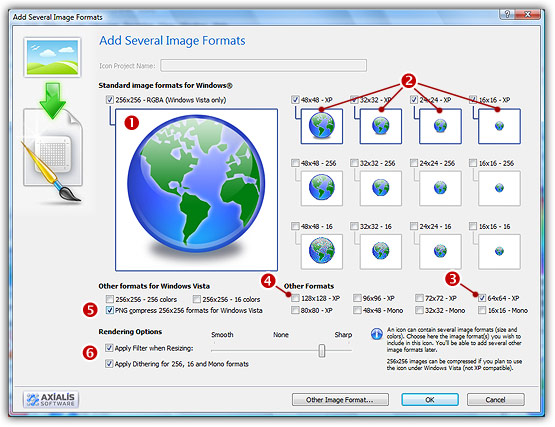
18. Select the images formats to include in the icon (![]() /
/ ![]() ) by clicking on the associated check boxes. Follow the specifications as we defined them above.
) by clicking on the associated check boxes. Follow the specifications as we defined them above.
19. You can also choose to apply the dithering option to the 256/16 color images as well as add a filter effect to smooth/sharpen the resulting images in RGB/A mode (![]() ). View the results in the preview images.
). View the results in the preview images.
20. When done, click OK. The new formats are automatically created and added to the project (![]() ):
):
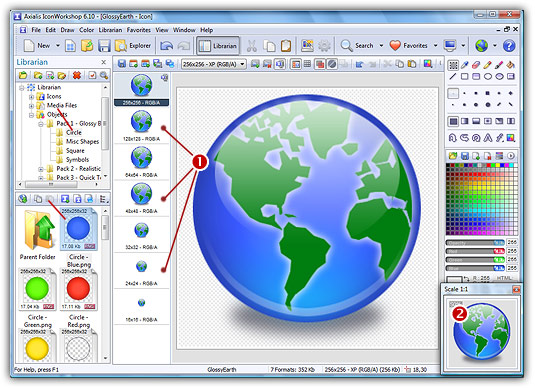
21. Take a moment to admire your work :) Click on the various formats (![]() ) and see the resulting icon at scale 1:1 in the preview window (
) and see the resulting icon at scale 1:1 in the preview window (![]() ). You can change the background lightness of the Scale 1:1 window simply by clicking in it using the left button of the mouse. It will permit you to see how the icon is displayed on different backgrounds with different lightness.
). You can change the background lightness of the Scale 1:1 window simply by clicking in it using the left button of the mouse. It will permit you to see how the icon is displayed on different backgrounds with different lightness.
22. Save your icon: Choose File/Save or press Ctrl+S. It will be saved as Windows® ICO format.
Congratulations! You've created your first icon from Image Objects. There is no limit to your creativity using these objects. You can resize them, changing their color, their opacity and more. You can even create your own objects by combining existing ones.
If you want to practice, try to recreate these sample icons made using the Glossy Objects pack:
![]()
Creating a Macintosh® Icon
You can easily create a Macintosh® icon using a similar procedure. When creating the project, choose "File/New/ Macintosh®Icon Project" or press Ctrl+M and follow the same building method.
You can also save your Windows® icon as Macintosh® format. When the icon is finished (step 22 above), choose File/Save as Macintosh®Icon or press Ctrl+Alt+S.
![]() By doing this, some icon formats which are not available for Macintosh® icons will be removed. In the example above, format 24x24 will be removed. An information message will be displayed.
By doing this, some icon formats which are not available for Macintosh® icons will be removed. In the example above, format 24x24 will be removed. An information message will be displayed.
![]() Downloading Object Packs from Internet
Downloading Object Packs from Internet
![]() Introducing Windows Vista™ Icons
Introducing Windows Vista™ Icons